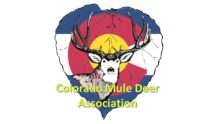Health Risks and Legal Violations Plague Colorado Wolf Introduction Program
Category: Uncategorized
2019 CMDA Banquet

Venison Recipe
Board Member Trina Duncan has a recipe that’s just killer. Try her Cozy Cabin Caserole. Afterwards, let her know what you think.
The New CMDA Logo

As we move into 2018, the Board wanted to make a new statement that we’re still here. We’ve rededicated ourselves to the tasks ahead. We have some new partners in our future and some old ones we’re glad to have with us as we make these next steps. Along with this, we’ve elected to refresh our logo a little. Let us know what you think. We expect to have some hats and sweatshirts available by the Banquet.
Wolf Killed in Grand County

Tests Confirm Coyote Hunter Killed Wolf In Grand County
The U.S. Fish and Wildlife Service confirms DNA tests on an animal shot by a coyote hunter on April 29 near Kremmling prove the animal is in fact a wild gray wolf.
Click on the link to for the CBS Interview link
We are Killing the Wolf!!

We are killing the Wolf, but not in the way that the General Public thinks we are. And in some respects, hunters and trappers are preserving them. We are talking about the True Pure Strain (Breed) of Wolf. The influx of the Easter Wolf into the human inhabited regions of the US has caused the Hybridization between coyotes and the Easterner Wolf, which is now called the Easterner Coyotes and Coy-Dogs. The so-called Eastern Coyotes were first sighted in the late 1930’s early 1940”s. They are 21% bigger on average than a true coyote. “The most plausible scenario is that the eastern coyote is actually a hybrid between coyotes and a small type of wolf. Dr. Brad White’s research team at Trent University reported that the wolves found in southeastern Canada may actually be the same species as the red wolf (Canis rufus, or Canis lycaon as proposed) found in the southeastern United States. This “eastern wolf” is smaller, weighing about 60 pounds, and is thought to be more closely related to the coyote than to the gray wolf because both are theorized to have evolved in the New World whereas the gray wolf originated in the Old World. Thus, White’s research group theorized that the genetic similarity of the coyote and Canis lycaon might facilitate hybridization, especially when populations are low in an area. (In fact, the biggest threat currently facing the red wolf in the southeastern United States is hybridization with coyotes colonizing the periphery of the North Carolina red wolf recovery area.) I have been collaborating with White’s genetic team, and they recently finished analyzing the genetic results of about 75 of our samples from eastern Massachusetts. Perhaps not surprisingly, they did find evidence for hybridization. They found that our study subjects were mainly eastern coyote, but all also had western coyote and eastern/red wolf genetic influence as well. White believes the eastern coyote should be classified as its own species because all of the samples from the Northeast (including from Massachusetts, New York, Maine, and New Brunswick) grouped more closely to each other than to western coyotes or wolves mycustomessaywriters. Interestingly, biologists call these same Canids “Tweed wolves” in Ontario, and White notes that they are a product of hybridization between eastern coyotes and eastern wolves.” Quote taken from article from Project Coyote, http://www.projectcoyote.org/newsreleases/news_eastern.html
ENDANGERED SPECIES

Date: Wed, 6 Mar 2013 17:05:
30 +0000 ENDANGERED SPECIES: 52 House members push for wolf protections Laura Petersen, E&E reporter Published: Wednesday, March 6, 2013 A coalition of House lawmakers is calling on the Fish and Wildlife Service to continue Endangered Species Act protections for gray wolves in the Pacific Northwest, California, the southern Rocky Mountains and the Northeast. Wolves have already been delisted in the northern Rocky Mountains and the western Great Lakes. The lawmakers, led by Reps. Peter DeFazio (D-Ore.) and Ed Markey (D-Mass.), want to prevent protections from being lifted in the rest of the lower 48 states. The duo and 50 colleagues sent a letter to Fish and Wildlife Service Director Dan Ashe this week asking that “the Service continue to protect wolves in the lower 48 states under the ESA.” “[W]e are concerned that the same prejudice towards wolves that led to their extirpation across nearly the entire coterminous United States is still present today and, not only is threatening to undo the gains achieved in the northern Rocky Mountains and western Great Lakes, but will prevent their recovery in additional areas,” the letter said. “We believe that federal protection continues to be necessary to ensure that wolf recovery is allowed to proceed in additional parts of the country.” The lawmakers are all Democrats except for Rep. Michael Fitzpatrick (R-Pa.). Gray wolves in Montana, Idaho, Wyoming and parts of Utah, Oregon and Washington were removed from the endangered species list by a congressional rider in May 2011. The Great Lakes population was also delisted in 2011 in a separate action by the Fish and Wildlife Service — a decision recently challenged in court by a coalition led by the Humane Society of the United States. The agency is reviewing the status of the gray wolf in the lower 48 states, according to the letter. If updated evidence shows the animals have recovered, FWS could propose removing them from the list. However, the Mexican gray wolf, which has struggled to recover, would most likely remain on the list. “A blanket national delisting of the gray wolf would be premature and would not be grounded in peer reviewed science,” the letter said. Since delisting, more than 1,700 of the 5,000 to 6,000 recovered wolves in the lower 48 have been killed, including many high-profile wolves from Yellowstone National Park, according to the Center for Biological Diversity.
Pete Obermueller
Legislative Director, Rep. Cynthia M. Lummis Executive Director, Congressional Western Caucus
A Knife for all seasons

On Feb 12, 2015 11:55 AM, “Ken Phippen” <kpknives@gmail.com> wrote:
The blank is 440c steel. Similar quality as the one I am making for a sample, so you will get an idea from the other knife. Most of the knife blanks from this particular company are 440c steel, which is a very good quality stainless steel.Some guys don’t like stainless steel. I have nice knives from other companies that are quality high carbon steel, just have to figure out how to get a nice logo on them. I’ll be working on that topic. I have a really great skinning knife from high carbon steel that is quality and sells for the same as these other two. It really is a skinner, so a pretty specialized shape. Might be one to consider in the future.
I have a few different high quality folding hunting knives. My clients are very pleased with the knives. The catch is this, I would need $80 for them if I can get at least 3 knives ordered. You guys could sell them for $100 or whatever you decide. This would be the knife and a belt sheath for the $80. I typically sell them for $100.
I sent you pictures of two of these folding knives. The Elk Hunter and the Moose Hunter. The Moose had the guthook, but I can get that one with or without the guthook. The Elk Hunter is a really solid feeling knife that everyone that handles it are very impressed.
I’ll likely take the plunge and get some logo templates for myself and if they work for me, it would be a way to get your logo on some of these other knives, like the folders or high carbon steel. I anticipate you don’t want to get too spread out with the knife options you are offering. Certainly start out with a bit more focused offering and see if the members are interested. I think a couple of fixed blade styles and a couple of folding hunters – maybe a guthook option and a non-guthook option.
I just checked. The knife with the logo is already out for delivery, so I should see it this evening. I’ll let you know how it looks.